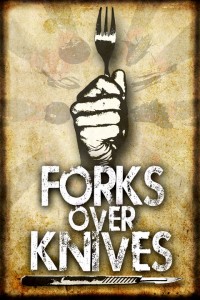
Forks over Knives, a movie whose theme is in the title: food will replace surgical scalpels for cancer, heart disease, obesity, type 2 diabetes, and others. Their answer is a “plant based” diet (Vegan). The movie provides three live anecdotes to prove this, and star T. Colin Campbell and Caldwell Esselstyn, Jr whose careers intersected with both having come to the same conclusion that a vegan lifestyle would eliminate heart disease, perhaps cancer, obesity, and other chronic illness.
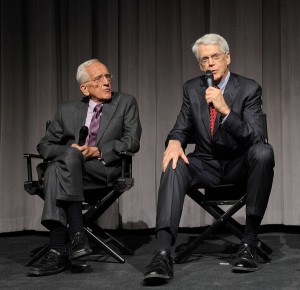
The two stars of the movie, answering questions at its opening
The movie started with lots of video of obese people, and the movie ended with most of the people in the movie sitting down having a friendly, plant-based meal: great cinematic contrast as this small band of people fighting diseases by eating plants.
Some consider this movie a documentary, especially those who advocate the whole plant (Vegan) lifestyle. It is not a documentary, a documentary is non-fiction, this is a movie, it is a hope, it is an unproven hypothesis. As much as we (physicians) would love food to solve medical problems, and there is no doubt food can cause problems, but food, as medicine is another matter.
We are introduced to the narrator, Lee Fulkerson, who presents himself to a clinic while smoking a cigarette and having left behind two empty cans of an energy drink, and stating he earlier drank a large cup of coffee. The clinic is a family owned clinic where the physicians, Drs. Matthew Lederman and Alona Pulde, promote a vegan lifestyle and will shop with the patients, cook with the patients, and watch their laboratory values improve. By the end of the film the narrator has lost weight, improved cholesterol, and improved his cardiac risk factors (they don’t tell you that the main reason for that improvement is he stopped smoking).
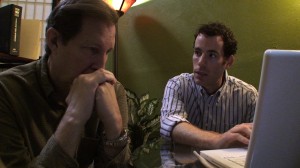
Lee Fulkerson looking over his lab results with Dr. Lederman
Much like the narrator doesn’t tell you that removing cigarettes, and weight loss were the primary improvement, the entire movie has a tendency to gloss over points, data, and misrepresent biology.
The good points of the movie are:
(1) The doctors
It is great to see the physicians who take time with patients to change and impact their lives. Drs. Esselstyn, Matthew Lederman, and Alona Pulde whose fundamental belief in prevention is to impact what a patient eats. If you believe that food makes that fundamental impact on health, these physicians make a tremendous investment in their time to helping these patients. Many of us are teaching patients how to cook, and what to cook and more physicians are taking the course at Culinary Institute/Harvard to learn to these skills. Changing lifestyle, spending time with patients, and having a positive impact is the ideal of primary care medicine.
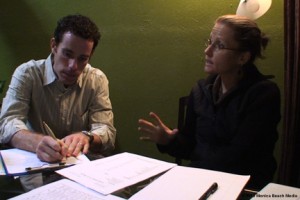
Dr. Lederman and Pulde are a great team in this movie
(2) Eating Healthier
Eating healthier is better than eating junk. No doubt the lady who ate her share of donuts into a heart attack helped herself by avoiding donuts. Whether she would have done just as well following a paleolithic diet as a vegan diet is debatable
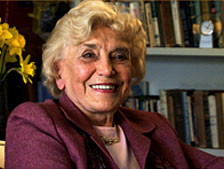
Told she had to go to a rocker, Ms. Oswick found Dr. Esselstyn, and now lives without her donuts and chocolate
(3) Feel Good Story
Watching a heartfelt good story: seeing people’s health improves, feeling better, and being more fit is a great story. Seeing physicians working to that end, as well as advocates of that position
The Incomplete Data
Cholesterol: The notions of cholesterol were not only out of date, but incorrect. Early on the narrator states that cholesterol is what forms the plaques in the arteries of the body. To quote, “But when we consume dietary cholesterol, which is only found in animal foods like meat, eggs, and dairy products, it tends to stay in the bloodstream. This so-called plaque is what collects on the inside of our blood vessels and is the major cause of coronary artery disease.” This is not how plaque forms, and dietary cholesterol is far less important. It may be that both T. Colin Campbell and Esselstyn were both trained in the era when cholesterol was thought to be the cause of the arterial plaques. It isn’t and there are more discussions about this here. Some people, who have minor elevations of lipids, can lower their lipid level (I avoid saying cholesterol because that is just not what we need to be talking about here) through diet, exercise, and weight loss alone, but before throwing away medications and eating plants they should be carefully monitored by their physician.
This is not a “minor slip up” in the movie- this is the first tenant of a plant based diet. It is also dangerously incorrect. Dietary cholesterol is avoided in a plant based diet, but a plant based diet does not avoid plaque in arteries.
The now clean arterial plaque:
One of Dr. Esselstyn associates had a heart attack- and they show the angiogram of his coronary arteries after the heart attack. You see the smooth arteries around this and then the ragged artery that caused the heart attack. After time on the plant based diet another angiogram was taken- and behold the artery is now clean.
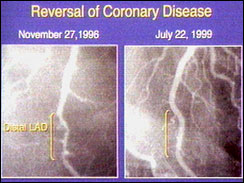
Left is a clot, the artery on the right is free of clot - it is NOT reversed disease
This is misdirection to the viewers. What they are seeing in that ragged artery is the remains of the clot in the artery that caused the heart attack. If a person survives, within a few days on aspirin that clot will disappear. The associate credits Dr. Esselstyn with saving his life, by putting him on the plant based diet. But the misdirection is egregious, planned, and is often replicated on many websites that advocate a plant based diet — they will either show an artery of someone who had a heart attack with remaining clot, and then show a clean artery- or they will give you a slightly different two dimensional view of the artery that is more favorable.
The Norway Data
Dr. Esselstyn then shows the data of mortality from heart attacks and strokes of World War 2 Norway, which drops dramatically after the Nazi take over, and confiscate the meat supply.
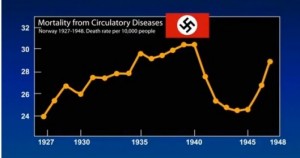
The death rate dropped before the Nazi's took the Norwegians meats
The first question one would ask — if this is true, if by removing meat you immediately see a drop in strokes and heart attacks? That is the implication. The problem is that Dr. Esselstyn’s conclusion about the data is missing a few points that might clarify the data:
The decrease in wartime heart disease and strokes was replaced with an increase in mortality from infectious disease, trauma (in war people tend to fire more bullets) – and in particular outbreaks of TB. The meats from the livestock were not taken by the Nazis until after this graph showed the dramatic decline (hence the drop was not because of less meat being consumed, in fact during this drop Norwegians consumed more meat because the Nazis had told the Norwegians they were going to confiscate their livestock, so many Norwegians simply slaughtered their animals and didn’t raise new ones the following year. Meat consumption during this “fall in the graph” was almost double what it was during normal times.
The fish consumption during these times doubled. Not that eating more fish will decrease coronary disease (except in large population series this is a trend).
While others have pointed out that sugar consumption decreased, wheat consumption decreased and thus they became a paleo society with an emphasis on fish (thought Norwegians were Lutherans and turned out they were Pescatarians) – it is a long stretch that any single change in a diet would cause a single year dramatic decrease in cardiac mortality and strokes (but would be great if it did). It fits the theme of the movie that the change to a Vegan diet will, within a year, dramatically alter years of coronary artery accumulation of plaque – it won’t.
Dr. Campbell’s cancer study:
Rats given more milk protein have more “foci” of cancer than rats fed less milk protein. Several issues with this study, and those conclusions. First, it wasn’t that the rats lived longer- they didn’t. The rats died from being a part of an experiment, and some rats died before they were suppose to– those rats all were the rats getting less of “mothers milk protein.”
Campbell takes the one milk protein and generalizes it to all animal proteins. Why? Proteins are chains of amino acids, and there is some magic about how a plant puts the amino acids together than an animal? Casein is a bio-active group of proteins found in milk- it stimulates tissues to grow, which is what you want mother’s milk to do- it is not just a source of nutrition but is a “bioactive protein” meaning it helps to turn on certain proteins. Take a rat liver, put it with a super high concentration of a protein that turns on proteins, and then add a cancer causing agent –well, it makes sense. But remember, these rats had better looking livers than the low protein rats (who died faster). Also whey protein, another milk protein, has been demonstrated to have some opposite effect with tumor. Some proteins are bio-active, and have effects when given in super concentrated form and isolated from their natural counter parts – like whey, they behave in not natural ways. Then to use this to make global conclusions about animal proteins is not science, it is prejudice. I discussed Dr. Campbell’s assumptions here.
Dr. Esselstyn’s patients:
Dr. Esselstyn took a bunch of patients with heart disease, convinced them to go on a Vegan diet (initially the group was allowed to have dairy til he met Dr Campbell then no dairy). Of this small group, six people dropped out. You can see more about his works on my previous post regarding him and this study.
While the study seems great, and they bring out two individuals who were a part of the original study (I think- they don’t really say that, and since the movie tends to gloss over details quite a bit one cannot make assumptions).
What is remarkable is that Dr. Esselstyn met with these patients every couple of weeks in his home. One sweet lady who had two heart attacks before 59 while eating a diet of chocolate and “every donut I could get my hands on and lots of gravy.” She also noted that Dr. Esselstyn, in spite of his “kind eyes” was quite strict “there’s the door.” That may explain why 6 of the original 24 dropped out. Of the remaining 18 the math gets a bit fuzzy. 6 had “evidence of regression of disease” 11 stabilized. But it turns out that Dr. Esselstyn’s math as presented was off, and not surprising, the data in this movie is driven by making a point, and not by precise details.
Esselstyn’s publication states he started with 22 patients, five dropped out, and six stayed on the diet but never came back for data collection—leaving Esselstyn with only 11 people in the study. The data from the 11 had stabilization of their heart disease, but four people had lesions that slightly progressed. The paper then looks at the method of regression of plaque, and these methods are now considered out-dated and of no use.
The high drop out rate could mean people either could not tolerate the diet, or died, or were asked to leave. The other issue is these patients had other interventions, such as statin agents that really do reduce arterial plaque formation. Esselstyn’s paper that does not rise to the evidence based medicine for major research. It is quite small, highly selective of the patients, not controlled for other interventions with heart disease (some patients had angioplasties, heart surgeries, and etc) – thus we cannot determine which intervention for this small group of individuals worked, if any. Why Esselstyn didn’t keep the other drop-outs on to serve as a control is deeply flawed. Throughout the years on this diet variables changed – such as removing dairy products, and even if there was a dietary answer to heart disease, it would be lost in the details.
As a personal anecdote, my father had a heart attack in 1979, was forced to retire at age 55, did not have angioplasty (not available then) and loves sugar, ice cream, peanut butter, meat, cheese, but he stopped smoking, retired, and 33 years later (and a few stents and an implantable defibrillator later). Looking at his previous angiograms- his disease has regressed (in spite of not being on a plant based diet, not being on a paleo diet, and not probably eating things that most diet zealots would shun). That is a series of 1, not 11 – but has as much validity as Esselstyn’s work. The question is, was it diet that did this for these 11 people? What happened to the others? What does this mean? The answer is that this is as much of an anecdote as my dad is.
The China Project
T. Collin Campbell, a physiologist, calls this massive study the highlight of his career. With his Chinese counterpart, Dr. Chen, they took the simple hypothesis: diet effects disease rate. By choosing rural villages with stable diets, and known health and mortality statistics assumptions could be made about how diet effects health.
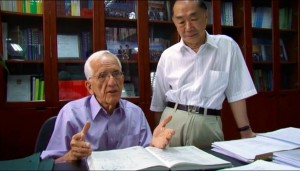
Campbell and Chen with their monograph
The film shows the proud researchers, with reams of data, and the NY Times Jane Brody column (Brody is not an authority figure but the implication that the NY Times said this was a good study is another logical fallacy called “appeal to authority.”).
There are major problems with the China Study – the blood samples of all individuals was pooled and studied – avoiding individual variation. The statistics for heart disease in rural villages in the 1970’s (they used this data for their study) was imperfect at best, and if you ask Chinese cardiologists today the current statistics – 30 years later – are poor. Heart disease is underestimated now, and even more 30 years ago. The same with cancer statistics, and most rural Chinese statistics.
The China Study has been uniquely reviewed and dissected by Denise Menger of rawfoodsos.com. She points out how the data sometimes shows the opposite of what is stated (much like this movie). For example, the meat eaters of one village had lower levels of the diseases.
OVERALL
This is a movie, and not a documentary. This is a movie that advocates a plant based (Vegan) diet will solve heart disease, cancer, and other ailments- and presents inadequate and skewed data to that end. To be clear, there is no substantial data that proves their point, and the data they use is skewed if not outright incorrect. It is a warm, feel good movie with some great people.
IF you wish to have a whole plant diet – then do so.. If you think you can throw your medicine away and just eat plants, do not do this without medical supervision – and by that I mean the MD or DO who prescribed the medication for you, or a physician that will monitor your blood levels of lipids, glucose, etc.
